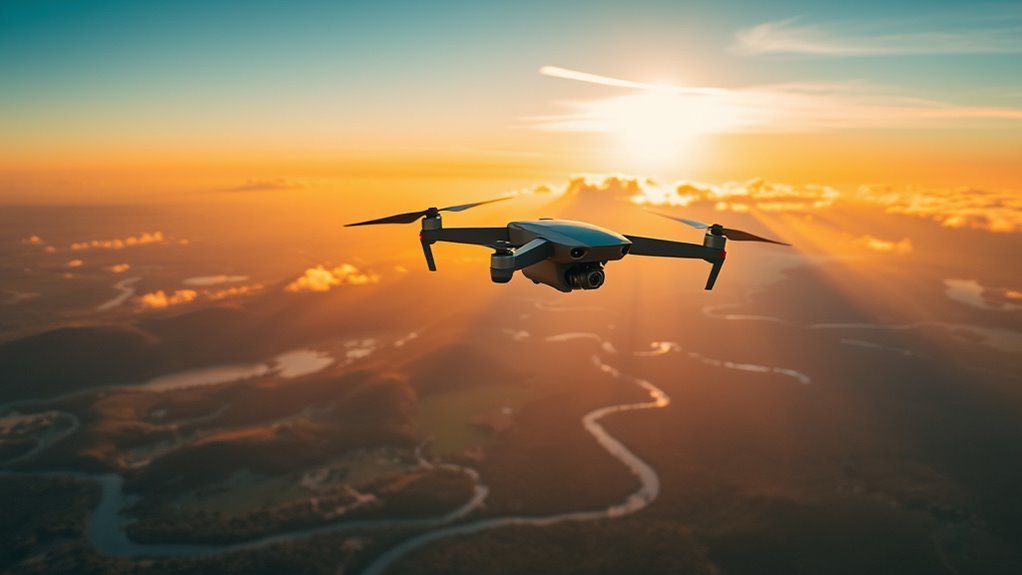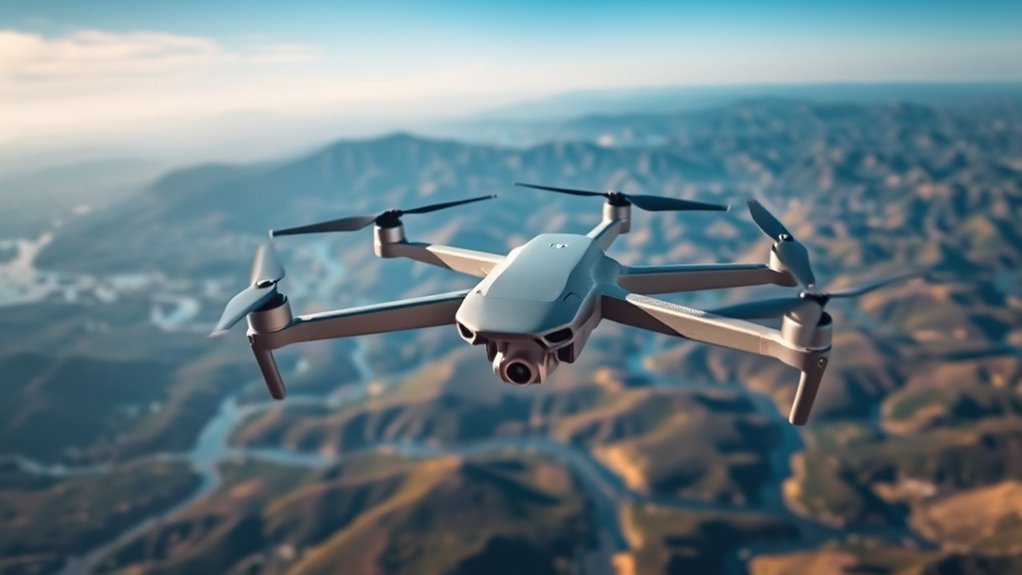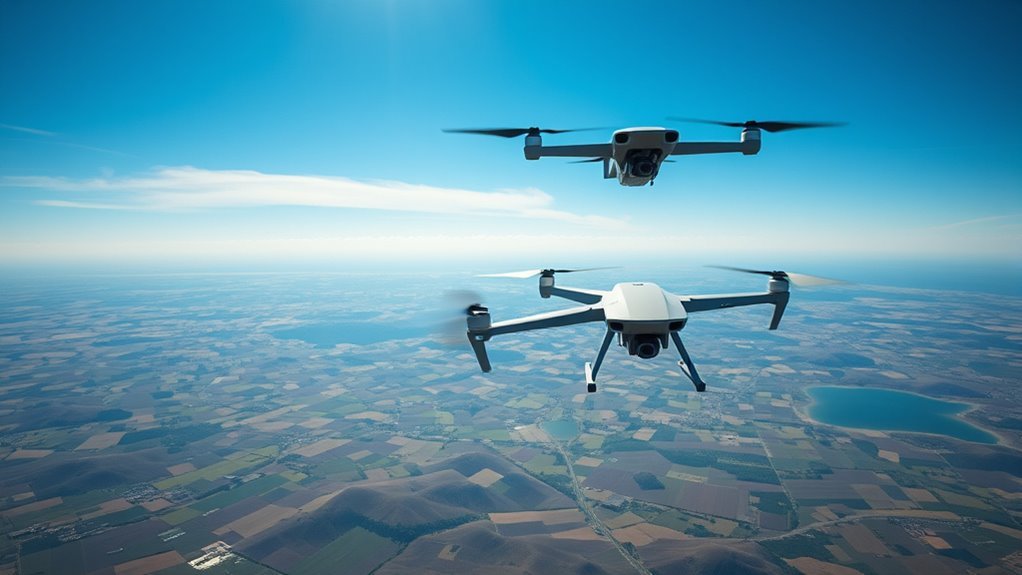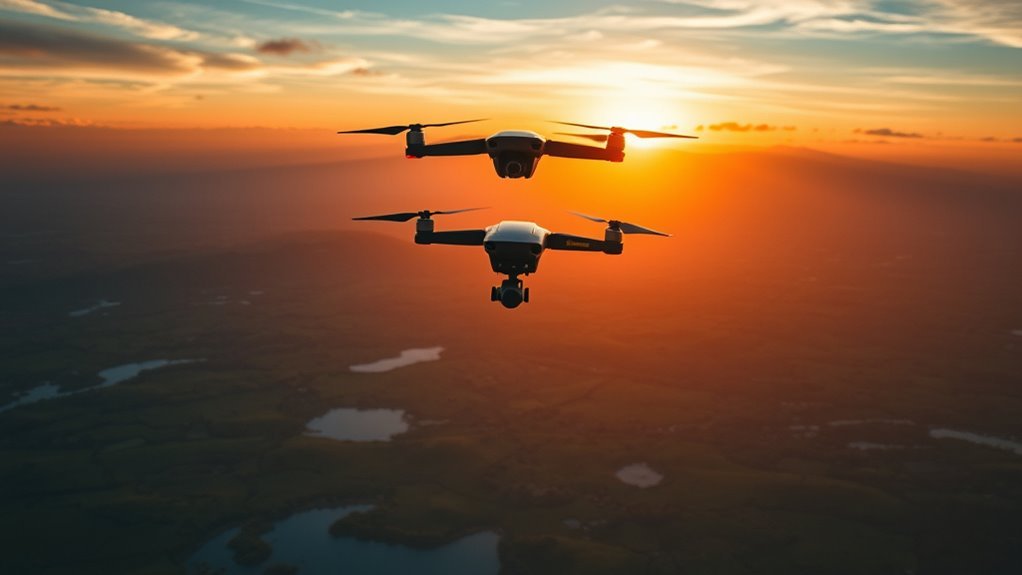Drones can reach impressive distances, with top models flying over 200 kilometers under ideal conditions. Factors affecting this range include battery life, aerodynamics, payload weight, and communication systems. Advances in battery technology enhance energy efficiency, while streamlined designs improve flight dynamics. Weather conditions also play an essential role in performance. If you’re curious about which specific models excel in distance and other key specifications, there’s more to discover in the following sections.
Understanding Drone Range: Key Factors

While many factors influence a drone’s range, understanding its operational limits requires a closer examination of several key elements. First, consider the drone technology employed; advancements in materials and design can considerably affect weight and aerodynamics. Next, analyze the flight dynamics, which include factors like altitude, wind resistance, and payload capacity. These elements interact to determine how efficiently a drone can traverse distances. For instance, a drone designed for stability in high winds may sacrifice speed for endurance. Additionally, environmental conditions, such as temperature and humidity, play an essential role. Weather conditions can significantly impact a drone’s performance and overall range. By grasping these factors, you can make informed decisions about your drone’s capabilities and maximize its potential for exploration and freedom in the skies. Furthermore, understanding battery capacity is crucial for determining a drone’s flight time and range.
Battery Life and Efficiency

Battery life and efficiency are critical factors in determining how far your drone can travel. Recent advancements in battery technology have improved energy density, but the weight and payload you choose can greatly impact flight time. To maximize your drone’s range, you’ll need to implement effective flight time optimization strategies. For instance, drones like the DJI Mavic 3 Pro can offer up to 46 minutes of continuous flight time, showcasing the benefits of advanced propulsion systems and optimized aerodynamics. Additionally, drones equipped with high-capacity lithium-polymer batteries are designed to provide stable power output, enhancing overall flight duration and reliability.
Battery Technology Advancements
Recent advancements in battery technology have markedly enhanced the efficiency and longevity of drone operations. Solid state batteries are at the forefront of this evolution, providing higher energy densities and improved safety compared to traditional lithium-ion batteries. These innovations allow you to extend your drone’s flight range significantly. Additionally, lithium sulfur advancements are pushing the boundaries further, offering up to five times the energy capacity of conventional lithium-ion systems. This means you can enjoy longer missions without the frequent need for recharging. As battery technology continues to evolve, you’ll find yourself with increased freedom in drone applications, enabling more ambitious projects and longer distances, all while maintaining reliability and performance in the field.
Weight and Payload Impact
As advancements in battery technology enhance drone capabilities, understanding the impact of weight and payload becomes increasingly important for maximizing battery life and efficiency. Your drone’s payload capacity directly influences its operational range; heavier loads require more energy, reducing flight time. Additionally, improper weight distribution can lead to inefficient flight patterns, compromising stability and control. To maximize your drone’s potential, it’s essential to balance the payload effectively. By strategically distributing weight, you can minimize drag and guarantee that the drone operates within its ideal performance window. This careful consideration of weight and payload not only extends battery life but also enhances the overall efficiency of your flights, granting you the freedom to explore further and accomplish more with each mission.
Flight Time Optimization Strategies
To maximize flight time while maintaining efficiency, it’s crucial to implement strategic optimization techniques tailored to your drone’s specific capabilities. Focus on enhancing energy management and refining your flight path optimization to guarantee smooth operations.
- Select ideal flight paths: Use software to calculate the most efficient routes, reducing unnecessary energy consumption.
- Adjust speed and altitude: Fine-tuning these parameters can lead to improved battery life and extended range.
- Monitor battery health: Regularly check battery performance metrics to avoid unexpected failures and maintain consistent energy management.
Communication Systems and Signal Strength

While the maximum distance a drone can travel is often discussed regarding battery life and physical design, the effectiveness of communication systems and signal strength plays an essential role in determining operational range. You need to understand that signal attenuation can greatly impact how far your drone can operate without losing control. Different communication protocols, such as Wi-Fi, RF, or cellular, each have unique strengths and weaknesses that affect distance and reliability. For instance, RF may provide a longer range but can be subject to interference, while Wi-Fi offers higher bandwidth but is limited in distance. Knowing these factors helps you choose the right system, ensuring your drone maintains a solid connection, even at extended distances. Additionally, understanding the differences in signal reliability between LTE and radio protocols can further inform your decision on communication systems.
Aerodynamics and Design Impact
Understanding how aerodynamics and design impact drone performance is essential for optimizing flight range and efficiency. The shape and materials used in drone construction play a key role in reducing drag and enhancing stability. By focusing on aerodynamic shapes and lightweight design materials, you can greatly improve a drone’s ability to travel longer distances.
Optimizing drone performance relies on aerodynamics and design, significantly enhancing flight range and efficiency.
- Aerodynamic Shapes: Streamlined designs minimize air resistance, enabling faster speeds. Additionally, proper payload distribution can significantly reduce energy consumption and improve overall flight efficiency.
- Design Materials: Utilizing advanced composites can reduce weight while maintaining structural integrity.
- Weight Distribution: Properly balanced drones enhance maneuverability and energy efficiency.
These factors directly influence how far your drone can fly, making it important to take them into account when selecting or designing a drone for maximum performance. Additionally, advancements in transmission technologies allow drones to maintain reliable connections over longer distances, further enhancing operational range.
Comparing Popular Drone Models
As you explore the various drone models available on the market, it’s crucial to compare their specifications and capabilities to determine which best meets your needs. Different drone brands offer unique features, affecting range, payload capacity, and battery life. For instance, DJI models typically excel in camera quality and flight stability, while Parrot drones may provide enhanced portability. You’ll want to analyze model comparisons focusing on distance capabilities, control range, and flight time. Additionally, consider the user interface and ease of use, especially if you’re new to drone flying. By carefully evaluating these factors, you can make an informed choice that aligns with your aspirations for aerial exploration and creativity. Many budget-friendly options, like the Potensic Atom, provide excellent flight range and value for novice pilots. Furthermore, the maximum flight range of popular models like the DJI Mini 4K can reach up to 10 km under ideal conditions.
Real-World Distance Records
In exploring real-world distance records, you’ll encounter some remarkable achievements in drone flight capabilities. The longest drone flight recorded showcases not only advancements in technology but also the potential for expanded applications. Additionally, notable distance feats highlight the evolution of drone performance in various environments.
Longest Drone Flight
While the advancements in drone technology continue to push the boundaries of flight capabilities, real-world distance records highlight the extraordinary potential of these unmanned aerial vehicles. Remarkably, the longest drone flight showcases impressive long-range capabilities and outstanding drone endurance.
- The record for the longest drone flight is over 13,000 kilometers.
- Innovations in battery technology have substantially improved flight times.
- Enhanced navigation systems enable precise long-distance travel.
These achievements demonstrate how far drone technology has come, allowing for unprecedented applications in various fields. As you explore the world of drones, understanding these records provides insight into their evolving capabilities and the future of aerial exploration.
Notable Distance Achievements
Drones have achieved remarkable distance records that reflect their growing capabilities and applications. In flight competitions, these unmanned aerial vehicles have set impressive distance benchmarks, showcasing their potential in both recreational and commercial uses. For instance, the current world record for the longest drone flight is over 200 kilometers, achieved under ideal conditions and advanced technology. Additionally, innovative designs have propelled drones to extraordinary distances, enabling them to cover vast terrains for mapping, surveying, and delivery services. The increasing pursuit of distance records not only highlights advancements in battery life and aerodynamics but also pushes the boundaries of what’s possible in drone technology. As these achievements unfold, they redefine the possibilities for drone applications worldwide.
Regulatory Considerations for Drone Travel
As regulations evolve, understanding the legal framework governing drone travel becomes vital for operators. Adhering to drone regulations guarantees you navigate airspace management effectively while maintaining safety standards. Be aware of licensing requirements and operational guidelines tailored to your specific applications.
- Compliance with privacy concerns is essential to avoid legal repercussions. Additionally, operators should remain informed about state and local laws that could affect their drone activities.
- Familiarity with international laws can broaden your operational scope.
- Acknowledging enforcement challenges helps mitigate potential legal risks.
- Furthermore, maintaining visual line of sight during flights is crucial for safe operations.
Future Innovations in Drone Range
Although advancements in battery technology and communication systems are essential, the future of drone range will depend heavily on innovative engineering solutions. Future technologies, like hybrid propulsion systems, are set to redefine what’s possible, integrating electric and fuel-based power for significant range enhancements. You’ll see drone designs employing lightweight materials to minimize energy consumption, allowing for longer flights without sacrificing payload capabilities. Autonomous navigation systems will also play a key role, optimizing flight paths and reducing unnecessary energy use. Additionally, advancements in LTE transmission technology could enhance connectivity and range in urban environments. In addition, advancements in solar energy capture could extend operational time dramatically. As these innovations converge, expect a paradigm shift in drone capabilities, giving you the freedom to explore previously unreachable distances. The horizon is broadening for drone technology, and it’s time to embrace it. These advancements could lead to drones like the Freefly Alta 8 Pro that maximize endurance and operational efficiency.
Frequently Asked Questions
How Do Weather Conditions Affect Drone Travel Distance?
Weather conditions can be a double-edged sword for your drone. Wind resistance can drain battery life, while temperature effects impact performance. Being aware of these factors helps you maximize your drone’s travel distance and freedom.
Can Terrain Type Impact a Drone’s Maximum Range?
Yes, terrain type can greatly impact a drone’s maximum range. Terrain obstacles and elevation changes can hinder signal strength and battery efficiency, ultimately affecting how far you can fly your drone effectively and safely.
What Payloads Reduce a Drone’s Travel Distance?
Isn’t it frustrating when payload weight drags you down? Heavier loads strain battery capacity, causing drones to travel shorter distances. Balancing payloads is essential for maximizing flight range and keeping your aerial adventures alive.
How Do Drone Flight Modes Influence Distance Capabilities?
Drone flight mode types considerably impact distance optimization. By adjusting settings like speed and altitude, you can enhance efficiency, allowing you to cover greater distances while maintaining stability and battery life for extended missions.
Are There Mobile Apps to Track Drone Travel Distance?
Yes, there are several drone apps available for travel tracking. These applications provide real-time data on distance flown, enhancing your flight experience and ensuring you stay within your drone’s operational limits for maximum freedom.

